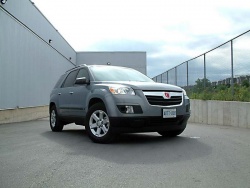 2007 Saturn Outlook. Click image to enlarge |
Review and photos by Laurance Yap
Discuss this story in the forum at CarTalkCanada
Find this vehicle in Autos’s Classified Ads
Photo Gallery: 2007 Saturn Outlook
My first reaction on hearing Saturn was going to call its new, big crossover the Outlook was, “Why would they want to name it after an e-mail program?”
Actually, if you’re willing to stretch a bit – and have an enthusiasm for Microsoft products that my Mac-snob mind doesn’t – the Outlook name makes perfect sense in this context. If you’ve ever used Outlook, you know it’s kind of a do-it-all program, with e-mail, a calendar, project management features and a souped-up address book. The Saturn version is kind of the same thing: it’s sort of an SUV, sort of a minivan and designed to meet all the needs of a growing family. Microsoft Outlook is a big program, taking up lots of space on your hard drive; the Saturn Outlook is a big vehicle, taking up lots of space on the road and a tough squeeze on tight urban streets.
Powered by a 3.6-litre V6 with variable valve timing – similar to the one used in the Cadillac CTS – coupled to a six-speed automatic transmission, the Outlook offers a surprisingly sophisticated powertrain set-up, especially given some of the growly, unrefined engines the brand has offered in the past. While you sometimes wish for more power, the combination of the 3.6 and the quick-acting automatic works very well in most driving situations and only feels burdened when you’re carrying a full load of passengers. Thanks to responsive kick-down performance, there always seems to be plenty of passing power and downshifts are accompanied by a high-tech snarl from the engine room that’s a pleasure to listen to in such a large vehicle. The downside of the hard-working six in a 2,132-kg body is fuel consumption: in a mix of city and highway driving, I managed no better than 13.0 L/100 km.
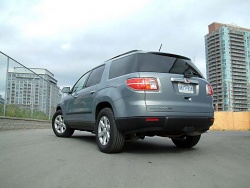 2007 Saturn Outlook. Click image to enlarge |
Sophisticated isn’t a bad word to describe the way the Outlook handles, either. While you are always aware of its bulk when cornering – particularly in the city, when its thick pillars impinge on your view around turns – the steering is accurate with good road feel and the chassis and Goodyear Fortera tires work together to deliver a composed, well-damped drive with surprisingly little body roll. Thanks to the huge 3,020-mm wheelbase and the tall sidewalls of those 18-inch tires, the Outlook’s ride quality is exemplary, smoothing out even the biggest bumps and heaves in town and on the freeway.
Demerits? The brakes offer fine stopping power but are connected to a pedal which feels completely dead under your foot; and parking this big beast can be a real chore, especially if you haven’t ordered the rear parking assist system (available only on the uplevel XR). The reason is not so much the Outlook’s big footprint, but its poor sightlines: the rear glass is tiny, mounted up high and framed by huge, wide pillars that make it difficult to judge just how far away you are from hitting the wall, or the car behind you.
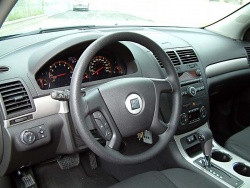 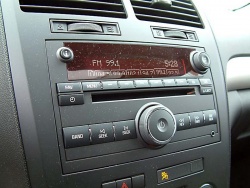 2007 Saturn Outlook. Click image to enlarge |
Small glass is something we’re getting used to in all cars these days as crash standards demand ever-bigger doors and pillars; unfortunately, they not only reduce visibility but can make an interior feel smaller than it is. That’s particularly true of cars with black cabins like the cloth-lined one in my base front-drive tester. Despite eight seats – five of which offer exceptional room for adults, with the three in back being just fine for short trips, or for children – and tons of head-, leg- and shoulder-room, the relentlessly black and charcoal tones of my Outlook felt oppressive. In cloth, the “Ebony/Light Cashmere” interior is still pretty dark; beige leather along with light wood-grain trim comes on the XR model at a significantly higher price.
No complaints, though, about the usability of it all. Thanks to its big body, the Outlook offers plenty of cargo space even when all three rows of seats are in use; it feels almost Suburban-large inside. There are storage bins, map pockets and cupholders in each of its four doors, a big two-level console bin and plenty of trays and containers to hold the detritus of everyday life. Thoughtful touches abound: a jack on the front of the easy-to-use stereo to which you can connect an MP3 player; twin sunroofs with mesh screens; a comprehensive trip computer; separate rear climate controls. Build quality, while not quite up to the standard established by the Japanese, is easily the best I’ve ever seen in a Saturn, with tight panel gaps and generally rich finishes; only a couple of out-of-the-way panels are made of the hard, scratchy surfaces of yore.
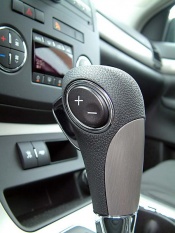 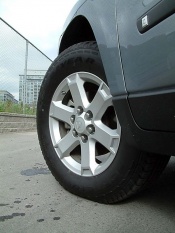 2007 Saturn Outlook. Click image to enlarge |
Unlike large truck-ish SUVs, access to all of the seats in the Outlook is easy. The step-in height is just right and the second row slides forward as the seatback flops down to make getting into the third row a cinch. Both the second and third rows can split as well as fold to create a load floor that is sort of flat. While the floor surface is uninterrupted from the back of the front seats to the cargo door, it is definitely higher up front, making the actual space kind of wedge-shaped; it is, nevertheless, big enough to swallow a serious load of flat-packed furniture, or whatever else you choose to throw in the rear.
Much like Microsoft Outlook, the thing about the Saturn is that it’s capable of so much – however I wonder how much of its capability its customers will actually use. And when you’re not using all of its seats and cargo space, you’re hauling around a lot of extra bulk. Then again, the same could be said for a lot of other large vehicles out on the road today and they – particularly large, truck-based SUVs like Suburbans and Yukons – are a lot heavier and guzzle a whole lot more gas than the Outlook. For about the same price as its closest competitor, the Chrysler Pacifica, the Outlook offers a lot more room and a better driving experience and a sharp-edged style that turns lots of heads.
While I’m generally more a fan of vehicles that are really good at one thing than vehicles that try to do everything, there’s a reason Microsoft’s managed to capture such a huge share of the market with its products. This new Saturn does a lot of things really well and looks good doing it; it’s just what Saturn needed to continue its forward and upward momentum.
Pricing: 2007 Saturn Outlook XE FWD
- Base price: $33,990
- Options: $4,045 (power dual sunroofs, $1,685; preferred package, $880; towing package, $550; cold weather package, $375; dual zone climate control, $295; xm radio, $260)
- Freight: $1,200
- A/C tax: $100
- Price as tested: $39,335
Manufacturer’s web site
- Click here for complete specifications
Related articles on Autos
Competitors
- Buyer’s Guide: 2007 Chrysler Pacifica
- Buyer’s Guide: 2007 Ford Edge
- Buyer’s Guide: 2007 GMC Acadia
- Buyer’s Guide: 2007 Honda Pilot
- Buyer’s Guide: 2007 Hyundai Veracruz
- Buyer’s Guide: 2007 Mazda CX9
- Buyer’s Guide: 2007 Nissan Murano
- Buyer’s Guide: 2007 Subaru B9 Tribeca
- First Drive: 2008 Toyota Highlander
- Buyer’s Guide: 2007 VW Touareg
Manufacturer’s web site








